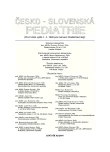Insulin Resistance in Children and Adolescents
Authors:
J. Malinčíková 1; D. Horáková 2; L. Čížek 2; J. Wiedermann 3; M. Kopecký 4; V. Janout 2
Authors‘ workplace:
Klinika rehabilitačního a tělovýchovného lékařství LF UP a FN, Olomouc
přednosta doc. MUDr. Č. Číhalík, CSc.
1; Ústav preventivního lékařství LF UP, Olomouc
přednosta prof. MUDr. V. Janout, CSc.
2; Dětská klinika LF UP a FN, Olomouc
přednosta prof. MUDr. V. Mihál, CSc.
3; Katedra antropologie a zdravovědy PdF UP, Olomouc
vedoucí doc. RNDr. J. Šteigl, CSc.
4
Published in:
Čes-slov Pediat 2007; 62 (4): 213-219.
Category:
Original Papers
Overview
Objective:
The aim of the work was to determine, in pubertal and prepubertal children, the mean values of limits of confidence for quantitative indices of insulin resistance and to evaluate the importance of these indices and other factors associated with the metabolic syndrome in the diagnostics and pathogenesis of insulin resistance.
Methods:
Five groups of children were examined – 33 healthy nonobese children at prepubertal age and 17 ones at the pubertal age, 15 children with overweight or obesity (BMI >90 percentile), 12 children with increased risk of incidence of the metabolic syndrome in family anamnesis and 14 adolescents with essential hypertension – quantitative homeostatic indices of insulin resistance HOMA IR and QUICKI were calculated in all of them and, at the same time, various metabolic and other indicators associated with insulin resistance were determined in serum.
Results:
The increase of insulin resistance in obese children was accompanied, among other known metabolic symptoms of insulin resistance, also by important increase of serum concentrations of leptin and IgG anticardiolipin and a significant decrease of serum concentrations of aFABP, TNFα and leptin receptors. Children with an increased risk of metabolic syndrome differed from the control group only in some metabolic indices, but the indices of insulin resistance were not significantly different. In boys with essential hypertension, there were only changes in some parameters (C-peptide, anticardiolipin IgG), HOMA IR a QUICKI were not significantly changed.
Conclusion:
The results confirmed the suitability of suing homeostatic indices od insulin resistance and some other factors for the early diagnostics of insulin resistance in children and adolescents.
Key words:
obesity, insulin resistance, homeostatic indices, metabolic syndrome, prepubertal children
Labels
Neonatology Paediatrics General practitioner for children and adolescentsArticle was published in
Czech-Slovak Pediatrics

2007 Issue 4
Most read in this issue
- Prenatal Corticosteroids and Their Effects on the Fetus and Newborn Infant: Known and Secret
- Duchenne Muscular Dystrophy in a Girl
- Newborn Screening for Cystic Fibrosis in the Czech Republic: Results of a Pilot Study
- Langerhans’ Cell Histiocytosis in Children – Clinical Presentation, Diagnosis and Contemporary Therapeutic Options
